Over one billion euro has been invested in the wellness and spa industry in Bulgaria over the past more...
| Search | Hotels / Accommodation | Vacations | Tours & Trips | Rent A Car | Transport | Flights | Conferences | Press Centre | Yachting |
- Hotels & Accommodation in Kavarna




- Otdih Hotel & Spa




- Villa Allegra
- Nearby hotels




- Topola Skies Complex



- Kaliakria Hotel
- Kavarna Guide
- Early booking in Kavarna
- All inclusive in Kavarna
- Last minute in Kavarna
- Hotels in Kavarna
- Apartments in Kavarna
- Villas in Kavarna
- Rural houses in Kavarna
- Vacations in Kavarna
- Transport To Kavarna
- Tours in Kavarna
- Conferences in Kavarna
- Articles on Kavarna
- News From Kavarna
- Holidays in Bulgaria
- All inclusive
- Beach
- Birdwatching
- Golf
- Health
- History
- Hunting
- Monasteries/ Religious
- Mountain biking
- Prom
- Rural
- Ski
- Spa & Wellness
- Trekking
- Water sports
- Weekend breaks
- Wine
- Conference
- Children Holidays
- Yachting
- Events
- Type of accommodation
- Hotels
- Apartments
- Villas
- Rural houses
- Destinations
- Aheloy
- Ahtopol
- Albena
- Apriltsi
- Arbanassi
- Asparuhovo
- Assenovgrad
- Bachkovo Monastery
- Balchik
- Bankya
- Bansko
- Banya (Karlovo)
- Banya (Razlog)
- Batak
- Beklemeto
- Belchin Bani
- Beli Iskar
- Belogradchik
- Berkovitsa
- Blagoevgrad
- Bodrost
- Bojichen
- Borovets
- Botevgrad
- Bourgas
- Bozhentsi
- Bratsigovo
- Brestovitsa
- Buzludja
- Byala
- Chepelare
- Cherepish Monastery
- Chernomorets
- Chiflik
- Devin
- Dimitrovgrad
- Dobarsko
- Dobrich
- Dobrinishte
- Dolna Banya
- Dospat
- Dryanovo
- Dupnitsa
- Dyuni
- Elena
- Elenite
- Elhovo
- Gabrovo
- Gela
- Golden Sands
- Gorna Oryahovitsa
- Gotse Delchev
- Govedartsi
- Grand Hotel Varna
- Harmanli
- Haskovo
- Haskovo Mineral Baths
- Hissarya
- Ivaylovgrad
- Kalofer
- Kamchia
- Kamen Bryag
- Kardjali
- Karlovo
- Kavarna
- Kazanlak
- Kiten
- Kom
- Koprivshtitsa
- Kosharitsa
- Kostenets
- Kostenkovtsi
- Kotel
- Kovatchevitsa
- Kranevo
- Kresna
- Kulinoto
- Kyustendil
- Lom
- Lovech
- Lozenets
- Lukovit
- Lyaskovets
- Madara
- Malko Tarnovo
- Malyovitsa
- Melnik
- Mezdra
- Momchilovtsi
- Montana
- Narechen Baths
- Near Golden Sands
- Nessebar
- Obzor
- Ognyanovo
- Osogovo
- Pamporovo
- Panagyurishte
- Panichishte
- Parshevitsa
- Pavel Banya
- Pavlikeni
- Pazardjik
- Pernik
- Petrich
- Pirdop
- Pleven
- Pliska
- Plovdiv
- Pomorie
- Pravets
- Preslav
- Primorsko
- Ravda
- Razgrad
- Razlog
- Ribaritsa
- Rila Monastery
- Riviera
- Rousse
- Rusalka
- Samokov
- Sandanski
- Sapareva Banya
- Semkovo
- Sevlievo
- Shabla
- Shipka
- Shipkovo
- Shiroka Laka
- Shkorpilovtsi
- Shoumen
- Silistra
- Sinemorets
- Sliven
- Smolyan
- Sofia
- Sopot
- Sozopol
- Srebarna
- St. Constantine & Elena
- Stara Zagora
- Starozagorski Baths
- Sunny Beach
- Sunny Day
- Sveti Vlas
- Svilengrad
- Svishtov
- Targovishte
- Teteven
- Tran
- Trigrad
- Troyan
- Tryavna
- Tsarevo
- Tsigov Chark
- Uzana
- Varna
- Varshets
- Veliko Tarnovo
- Velingrad
- Vidin
- Vitosha
- Voneshta Voda
- Vratsa
- Vratsata Gorge
- Yagoda
- Yakoruda
- Yambol
- Zlatitsa
- Zlatograd
- Bulgaria Guide
- General information
- Bulgarian Monasteries
- SPA Bulgaria
- The Black sea
- History
- Geography
- Maps
- Weather
- Airports in Bulgaria
- Webcams
- Forums
- Mountains in Bulgaria
- The Balkan Mountain Range
- Rila Mountain
- Pirin Mountain
- The Rodope Mountain
- Vitosha Mountain
- Travel Arrangements
- Visit Bulgaria
- Visa Requierments
- Choose Destination
- Flights to Bulgaria
- Transport in Bulgaria
- Advice
- Currency
- Official Holidays
Subscribe to newsletters to receive our hottest offers:
| Home > Dobrich > Kavarna > News |
Kavarna Beyond the Rock Scene
Sega daily, Tourism enclosure, Milena Mileva, 14 June 2008
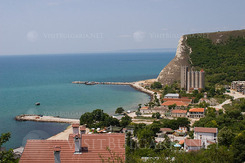
During the last years Kavarna became a synonym of the “summer rock capital of Bulgaria”. There is no doubt that the coastal town deserves its glory, but actually beyond the musical events, Kavarna has a lot to offer to tourists.
The picturesque coast line of Kavarna is 42 km long and small beach strips are developed along it, and the magnificent scenery is completed the steep and difficult to access cape Chirakman. However Kavarna is attractive not only for its natural beauties, but also with its rich history. Regular archeology expeditions are taking place in the region and the findings from the underwater studies attract the attention of the foreign explorers – several years in a row, scientists from France and Italy attend the excavations in the region.
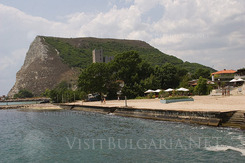 The town was founded during the Vth century B.C. by Greek colonials, who settled the colony Bysone in the plateau of cape Chirakman. Later during the III-II centuries B.C. skits tribes settled in the region. During that time the town plays an important role in the trade between the merchants from Rhodos Island, Heracleya and Synop, Efypt and etc.
The town was founded during the Vth century B.C. by Greek colonials, who settled the colony Bysone in the plateau of cape Chirakman. Later during the III-II centuries B.C. skits tribes settled in the region. During that time the town plays an important role in the trade between the merchants from Rhodos Island, Heracleya and Synop, Efypt and etc.
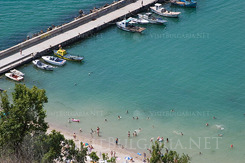 During the second half of the Ist century B.C. a catastrophic earthquake drowned the antique town in the sea.
During the second half of the Ist century B.C. a catastrophic earthquake drowned the antique town in the sea.
During the Roman period the town was restored under the same name and quickly flourished, the village revived and the port become busy. The town existed with this appearance until the VII century, when it was demolished by the Slavs and the Bulgarians, who created the settlement Karvuna. During the XV – XIX century the medieval town became famous under the name Kavarna, as a Christian village and a port for corn foods. The old bath, the medieval necropolis, bridge, the fountains and the Christian churches from that time are still preserved.
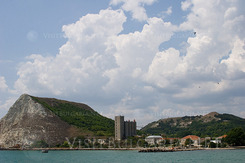 Even if you are one of the biggest fans of rock, do not miss to visit some of the must to see sights nearby Kavarna.
Even if you are one of the biggest fans of rock, do not miss to visit some of the must to see sights nearby Kavarna.
The first one is cape Kaliakra. It is jutting 2 kilometres inside the sea and is just 8 km away from the Balgarevo village; the cape is a natural and archaeology reserve. Numerous archaeology remains are preserved in the site – fortification walls, medieval churches, roman bath, water conduct, tombs and public buildings.
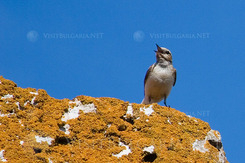 The next obligatory stop is the Yailata – the national archeology reserve. Yailata is a sea terrace, separated by the Dobrudzha plateau with 50 – 60 meters high rocks. A cave village with over 100 caves from the Vth millennium B.C. is located in the site. During the medieval ages the caves were used as a monastery complex and visitors can still observe wall paintings in Old Bulgarian language in some of them.
The next obligatory stop is the Yailata – the national archeology reserve. Yailata is a sea terrace, separated by the Dobrudzha plateau with 50 – 60 meters high rocks. A cave village with over 100 caves from the Vth millennium B.C. is located in the site. During the medieval ages the caves were used as a monastery complex and visitors can still observe wall paintings in Old Bulgarian language in some of them.
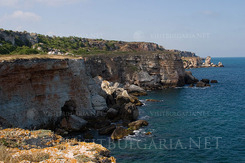 20 km east of the town is the vacation village “Rusalka”, situated in the unique nature reserve ”Ptichi Zaliv” (the bay of the birds) and further north is cape Kaliakra. The region is one of the few still preserved wild steppes on the European continent. The cut rocky coast, the small secluded sand strips, the venerable oak threes and vegetation, attract millions birds and transform the “Ptichi zaliv” into an oasis of the intact nature. Numerous archaeology findings can be explored along the coastline, some of them date back from 8000 years.
20 km east of the town is the vacation village “Rusalka”, situated in the unique nature reserve ”Ptichi Zaliv” (the bay of the birds) and further north is cape Kaliakra. The region is one of the few still preserved wild steppes on the European continent. The cut rocky coast, the small secluded sand strips, the venerable oak threes and vegetation, attract millions birds and transform the “Ptichi zaliv” into an oasis of the intact nature. Numerous archaeology findings can be explored along the coastline, some of them date back from 8000 years.
If you do not want to get out of the favorite town, you will also find curious things to see and do. Majour attractions are the 12 old spring fountains, situated in the valley towards the harbour. Some of them are ruined, and the rest were lately restored.
It is worth to visit the exposition “Dobrudzha and the sea”. It is a small sea museum, situated in a restored old Turkish bath.
The town’s museum is situated in close vicinity to the hamam. Artifacts from the life of the inhabitants of the region are exposed in the museum. A model of a prehistoric cave settlement is also exhibited in the site.
The ethnographic museum, on the other hand presents the local outlets, decorations and fabrics. The ethnographic museum itself is a beautiful old house from the end of the XIXth century and was owned by a rich family. The interior reveals the home lifestyle and culture of the majour groups inhabiting the region – people from Dobrudzha, Kotel and gagauzi. The building is surrounded by a picturesque garden with mulberry threes, peonies and tulips.
Numerous café’s, pubs and mehanas offer delicious local dishes to the numerous visitors of the town. The most popular dish offered in town is the so called “Katino meze”. It is being prepared by pork meat, mushrooms, onions and lemon juice. It is named after the famous chef – aunty Katia. During the Balkan war she was chef in the 18th Bulgarian garrison.

















